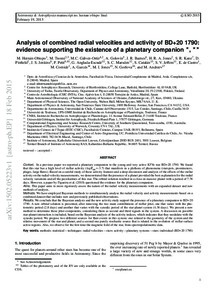Analysis of combined radial velocities and activity of BD+20 1790: evidence supporting the existence of a planetary companion
Galvez-Ortiz MC; Cornide M; Garces A; de Castro E; Catalan S; Petit P; Golovin A; Jones MI; Gorlova N; Kane SR; Pinfield D; Jenkins JS; Marsden SC; Anglada-Escude G; Hernan-Obispo M; Tuomi M; Jeffers SV; Jones HRA; Barnes JR; Andreev M
https://urn.fi/URN:NBN:fi-fe2021042714064
Tiivistelmä
Results. We conclude that the Bayesian analysis and the new activity study support the presence of a planetary companion to BD+20 1790. A new orbital solution is presented, after removing the two main contributions of stellar jitter, one that varies with the photometric period (2.8 days) and another that varies with the synodic period of the star-planet system (4.36 days). We present a new method to determine these jitter components, considering them as second and third signals in the system. A discussion on possible star-planet interaction is included, based on the Bayesian analysis of the activity indices, which indicates that they modulate with the synodic period. We propose two different sources for flare events in this system: one related to the geometry of the system and the relative movement of the star and planet, and a second one purely stochastic source that is related to the evolution of stellar surface active regions. Also, we observe for the first time the magnetic field of the star, from spectropolarimetric data.
Kokoelmat
- Rinnakkaistallenteet [19207]
